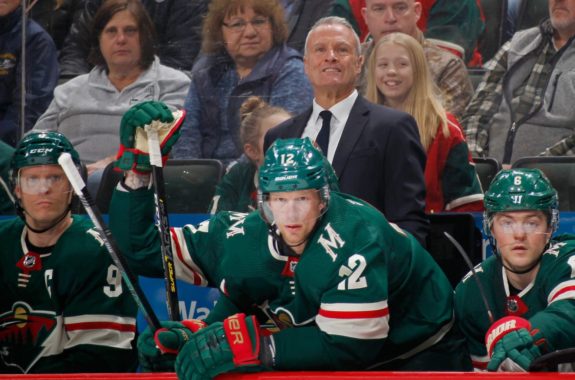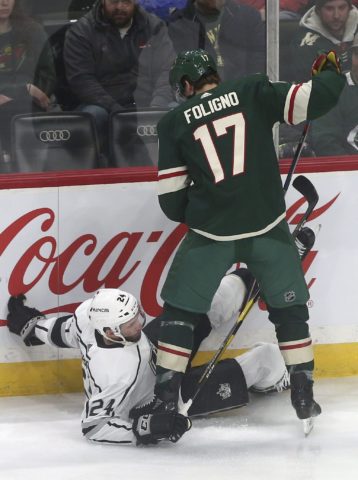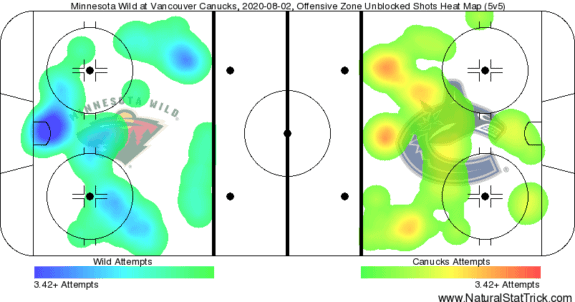Almost any coach that you could interview would tell you that the keys to winning a hockey game are:
- Stay out of the penalty box
- Compete hard and win 50/50 puck battles
- Play stiff in your own zone
- Keep your goalie’s vision clear and give him a chance to make a save
The Minnesota Wild did all these things in their Game 1 matchup against the Vancouver Canucks.

Combine this solid play with some power play success, excellent goaltending and putting the opposition completely off their game, you have a recipe for a playoff victory. In Game 1 of this postseason, the Wild gave the Canucks all they could handle and head coach Dean Evason is probably pretty happy.
Setting the Physical Tone Early
Within the first 2 minutes of the game, Marcus Foligno and Michael Ferland dropped their gloves and fought. It was basically a draw with Foligno’s face getting cut up a bit. It was surprising for me to see a player with Ferland’s concussion history decide to participate in a fight with Foligno. Following the fight, the game continued to be a physical contest. Both teams attempted to make it clear to one another that this was going to be a physical battle.

By the end of the game, a total of 68 hits had been tallied, including 28 for Minnesota and 40 for Vancouver. Both teams made a point to play the body and be physically tough. Wall battles turned into true physical conflicts and both sides saw players finishing checks well after the puck was gone. There were several hits that could have been interference calls but were not.
Related: Revisiting the Brent Burns Trade
Ryan Donato, Ryan Hartman, Luke Kunin, and Foligno all registered at least 3 hits apiece, with Foligno registering 7 in 12:11 of ice time. Jordan Greenway and Zach Parise also got involved physically. Parise spent much of his night going tit for tat with Canucks’ defender, Alex Edler. In spite of the high level of physicality, the Wild managed to, mostly, stay out of the penalty box.
Winning the Special Teams Battle
The Wild managed to avoid giving the Canucks a power play until 4:41 remained in the 3rd period. The Canucks were not so fortunate. The Wild scored power-play goals in the 1st and 2nd periods giving them a 2-0 lead.
Kevin Fiala opened the scoring in the game just 2:50 into the match after Tyler Myers was called for an egregious cross-check. From the left side circle, center, Eric Staal won the faceoff back to defender Jared Spurgeon. Spurgeon sent the puck across the ice to Fiala, who already had his slap shot wound up.
Related: Canucks – Revisiting the Luongo Trade
Fiala’s slapper caught goaltender Jacob Markstrom between the glove arm and his body. He got a piece of it, but the shot had enough power and velocity to trickle through and go in the net. Less than 3 minutes into the game, the score was 1-0 Wild, and the Canucks would trail the rest of the night.
The second power-play goal is summed up very well by analyst and former NHL goaltender Mike McKenna:
The dreaded floor bomb…
— Mike McKenna (@MikeMcKenna56) August 3, 2020
Markstrom was screened everyone. 90% of the time that shot comes high over the D in front of him because the shooter only sees open net there.
That is a REALLY intelligent shot by Spurgeon.
The Wild would finish the game 2-for-4 on the power play – a very nice conversion rate.
Related: 7 Takeaways From Canucks’ Exhibition Loss to the Jets
As mentioned, the Wild’s penalty kill didn’t have to make an appearance until late in the third period. The power play was a strong point for the Canucks in the regular season, with their 24.15% power-play conversion rate finishing 4th in the NHL. The Wild had the 7th-worst penalty kill in the NHL during the regular season with a 77.18% kill rate. Staying out of the box and keeping their opposition off the power play is going to be a key for victory going forward in this series and possibly beyond.
Compete Level and Puck Battles
Coaches are always talking about “compete level” and “puck battles.” They’re modern buzzwords that fall under the umbrella term of “playing the right way.” The film from this particular game could be used by hockey coaches to demonstrate that concept and show how it can help you win.
The Wild’s combination of veteran forwards, stalwart defenders and younger scrappier kids all worked equally hard to get to loose pucks. Every individual corner battle was contested as if the outcome of the game was riding on it. Every open-ice, 50/50 puck was attacked at top speed. The result was a Canucks group that could not gain any time in space to make plays.

The Canucks’ highly-skilled, young players found themselves smothered and stifled by defenders and backchecking forwards at every turn. Even though the Canucks managed 28 shots on net, the majority of these shots came from the outside and low danger areas. 17 of the Canucks’ 28 shots were fired by defenders. Top regular season point producers like JT Miller and Elias Pettersson found themselves unable to find the space to operate and generate offense like they would normally expect to. Bo Horvat, Tyler Toffoli, Tanner Pearson, and Adam Gaudette were prevented from taking any shots at all.
Often when teams find themselves unable to penetrate “danger areas” to generate scoring chances, they take “low danger” shot attempts from the outside, hoping to generate rebounds, tips and deflections. Shots from the point that in other circumstances would likely result in juicy rebounds for forwards to pounce on, were instead cleared away by alert, hard-working defenders. The Wild effectively shut the Canucks down by outworking them and out “competing” them in the Wild’s zone. This made it very difficult for the Canucks to generate the type of offensive zone play that they are used to generating.
Stalock Shut The Door
If you watched goaltender Alex Stalock lead the Wild down the tunnel on the broadcast, you saw a goaltender with spring in his step, giving off an aura that he had all the confidence in the world. He certainly played like it.
LOUD NOISES.#mnwild | #LetsPlayHockey pic.twitter.com/rKFWNAuAQS
— Minnesota Wild (@mnwild) August 3, 2020
Through 28 shots against, Stalock confidently positioned himself to “attack” shots. His defense stepped in when necessary and cleared out rebounds before Canucks players could pounce on them. While Stalock has been exceptional for the Wild at times, he is also known for his “adventures” away from his net.
But, coach Evason seems to have worked Stalock’s adventurous nature into the Wild’s game plan as the goalie and his defense appeared to be on the same page the entire night. The result was a postseason shutout for Stalock and a confidence boost for a fan base that didn’t know who the starting goaltender was going to be until shortly before puck drop.
Related: Wild’s Late Streak Secures Spot in Proposed 2020 NHL Playoffs
If the Wild can continue to play the way they played Game 1 of this series, they are going to be a very difficult team to beat. They simply did everything right. The key for them going forward is for their coach to find a way to use this game as a building block. This brand of hockey is very effective for playoff hockey: fast, hard-hitting, defensively sound hockey while their gifted forwards forced the Canucks’ netminder to stand on his head just to keep his team in the game. It was fun to watch and should be a recipe for success in this series.